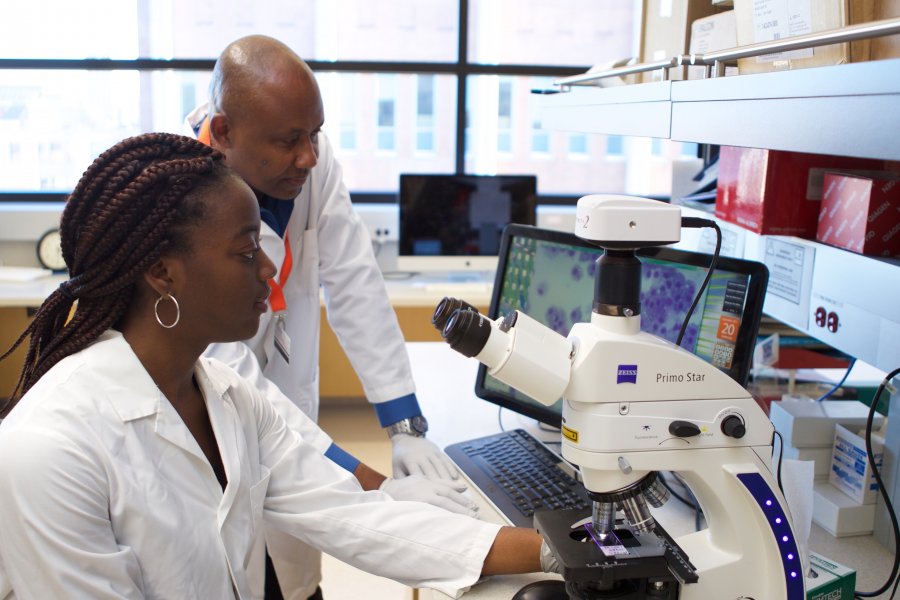
Discover your invention’s amazing potential
The main goal of our office is to translate UM derived ideas out into the world to maximize their social and economic impact. To accomplish this goal, our team specializes in intellectual property, business development and commercialization to turn UM inventions into products, services, research tools, and start-up companies.
What is Intellectual Property?
“Intellectual Property is the product of a cooperative relationship between the university and its members that is derived from the creative energies of the members fostered by the academic community and the university environment, including resources provided by the environment.”
UM Policy on Intellectual Property
The World Intellectual Property Office defines Intellectual Property (IP) as “creations of the mind, such as inventions, literary and artistic works, designs; symbols, names and images used in commerce”.
IP may be divided into five categories. This includes patents, trademarks, industrial design, copyright and trade secrets. All IP with the exception of trade secrets is country specific.
What is an Invention?
According to the Canadian Patent and Intellectual Property Office (CIPO), an invention is "any new and useful art, process, machine, manufacture or composition of matter, or any new and useful improvement in any art, process, machine, manufacture or composition of matter."
An invention is something that is more than idea or theorem. The act of inventing involves two stages:
- conception (the idea)
- a reduction to practice. To this end, all inventions must be supported by experimental data to demonstrate that the idea is at least “plausible” and/or validated.
For an invention to qualify for patent protection, an invention must be novel, not obvious and have utility. So what does that mean? Let’s take a look…
New or novel: The invention has to be different and distinguishable from anything that is publically known or available. The invention would not be considered new or novel if it had been previously patented, or if a similar invention is already in public use or if the invention has been publicly disclosed.
Not obvious: The invention cannot be an obvious or be an extension of another existing invention, as determined by a person “with ordinary skill in the art at the time of the invention.”
Utility: an invention is “useful” if it provides some identifiable benefit and is capable of use.
Who are inventors?
The term “inventors” refers to people who have created an invention.
Inventors at the UM might include:
- UM undergrad and graduate students
- UM researchers, associate professors, professors, research associates, postdocs
- UM technicians
- Post-secondary institution researchers in Manitoba
Inventorship is different than authorship. A person may be an author or co-author of a publication describing an invention, but will not be considered a co-inventor unless he or she made an independent conceptual contribution to the invention.
An invention may have more than one inventor. However, each inventor should have made an intellectual contribution, independently, to at least one element of a claim in the patent. While the contributions of the co-inventors may not have been equal, it is important to name inventors correctly on a patent, as improper naming of inventors can be grounds for rendering the patent unenforceable.
What is a Patent?
A patent is an exclusive right granted for an invention. It provides protection against others making, using, or selling your invention. Protection is granted for a limited period of time, generally twenty (20) years.
What is a Trademark?
A trademark is a distinctive sign that identifies certain products or services produced or manufactured by an individual or a company. It serves to protect a unique combination of words, designs, or both that identify specific goods or services. The period of protection varies, but a trademark can be renewed indefinitely.
What is an Industrial Design?
An industrial design refers to the aesthetic aspects or ornamental design. It provides protection of visual features such as the shape or surface of an article, or provides protection for unique product design features; including patterns, color or lines. An industrial design is primarily of an aesthetic nature, and any technical features of the article are not protected by the design registration. The term of protection is generally five (5) years, with the possibility of further renewal for a period of up to fifteen (15) years.
What is a Copyright?
Copyright laws grant artists, authors and other creators protection for their literary works and artistic creations. In general, the right holder(s) of a “work” can authorize or prohibit its reproduction, its public performance, broadcasting, translation into other languages and its adaption. The economic rights relating to copyright are of limited duration, beginning with the creation of the work, and lasting for not less than fifty (50) years after the creator’s death. Moral rights, and the right to oppose changes to the work last for generally the life of author plus seventy (70) years. Moral rights ensure the author’s creation are fully preserved and recognize the unique connection to their work. Moral rights are also necessary to protect the author’s reputation in the situation where the works that they created are altered without permission.
What is a Trade Secret?
Trade secrets include information derived from secrecy that is valuable to a business. In Canada, there is no formal intellectual property process to protect a trade secret, but they can potentially last forever provided the information actually remains a secret. Generally, trade secrets are used to: (i) ensure an invention or design is not disclosed to the public prior to seeking IP protection, (ii) to protect an invention without patent protection, (iii) protect business information that cannot be protected through other IP rights.
Keeping your ideas confidential
Any public display or disclosure of the results or process of the invention compromises its ability to be protected. We encourage our researchers contact our office if they may have created an invention with commercial potential and to maintain confidentiality of the invention until patent protection is applied for. Forms of public disclosure include publications, conference presentations, abstracts or posters, thesis presentations, press releases, or other forms of public communication.
As an academic and educational institution, we recognize the need for UM researchers to publish their research results in a timely manner. Seeking patent protection does not generally delay publication of research results. We are committed to working with patent attorneys to accommodate publication dates. However, our office strongly recommends that each invention be submitted as an Invention Disclosure at least three months in advance of public disclosure to allow enough time to review the discovery and to work with an external patent attorney to draft the patent application. A good time to disclose to our office is when the first draft of the anticipated paper is being drafted.
Who owns inventions developed at the UM?
UM inventors have the obligation to disclose their inventions to the University.
The University of Manitoba IP Policy determines ownership and rights associated with inventions created at UM. In general, the University and the inventors jointly own all inventions developed using University resources as a result of the research effort of faculty members, staff, and graduate students unless the rights to the invention were ceded (whole or in part) to a third party under a prior written agreement as researchers may have agreed to under a research agreement (UMFA Agreement).
How are inventions assessed by the Partnerships and Innovation office?
While we encourage researchers to contact our office as early as possible in their exploration of a potential commercialization or technology mobilization opportunity, filing an invention disclosure form (IDF) with the Partnerships and Innovation office is the first step in our undertaking a substantive assessment of the opportunity. The IDF asks for a brief description of the invention, the funding sources used, any and all inventors, as well as the potential commercial applications of the technology.
What to expect after disclosing an invention?
Once we receive your invention disclosure form, a Technology Transfer Specialist will work with the inventor(s) to assess the potential of the innovation. After an initial review of the technology, the Technology Transfer Specialist will consult the inventors with questions to clarify the invention. Following this review period, the technology will be further assessed for its ability to be protected and its commercial potential. While each technology is assessed on a case-by-case basis, the main evaluation criteria utilized in this assessment includes:
- Determining potential products arising from the invention
- Determine the competitive advantage of the potential products
- A market assessment, including market size, the point of entry, distribution channels, and any receptors or partners for development of the products
- Feasibility of manufacturing the product
- Determining if the technology is patentable, or protectable by another form of Intellectual Property
- Determine with the inventor any third-party rights that funders or other collaborators might have in the technology
- Assessing whether or not the technology was publically disclosed
- Assess whether the technology is best suited as a new venture or a license to an existing company
- Any regulatory issues
Our office will provide the rationale and the assessment will be shared with the inventors.
What if the invention was created with an inventor external to the UM?
If the technology was created with an inventor external to the UM, our office will establish an Inter-Institutional Agreement with the other institution(s). The terms of this agreement may include (and are not limited to) confidentiality, leadership of IP protection and commercialization efforts, and shared costs and revenues related to the technology.
What if my invention is software? Can it be patented?
Software can possibly be patented, but it is challenging as it difficult to prove as novel and non-obvious. In general algorithms and formula are not patentable subject matter, so a careful review of software and its functionality must be completed. Additionally, given the time to market for software products, the technology may be obsolete before the patent is issued. Our office has been highly successful in licensing and commercializing software without formal IP protection.
Can my invention be commercialized even though it’s not patentable?
In many cases, yes, but it depends on the nature of the work, the competitive landscape and many other factors.

How is my invention commercialized by the Partnerships and Innovation office?
After deciding to move forward with an invention, our office will actively work to commercialize the technology either by licensing the technology to an industrial partner, or creating a new company based on the innovation.
Generally, the process and path forward for successfully licensing an invention to an existing company is defined as follows:
- Ensuring strong IP protection can be obtained
- Developing marketing materials
- Advertising and marketing the technology
- Identifying and targeting suitable potential recipients for the technology
- Contacting and meeting with any interested parties
- Negotiating a licensing agreement or an option agreement on behalf of the inventors
It is important to note that due to the early stage of discovery of most UM inventions, the licensing process can often take several years before the invention is commercialized. In most cases, additional development work is often needed to validate the invention to demonstrate proof of concept. Once the technology is licensed however, the licensee is responsible for the advancement of the technology into a finalized product or service.
Technology Transfer Lifecycle
The Road to Tech Transfer: “It’s not fast…or simple.”
This detailed map describes the journey from invention to the marketplace. Learn about invention disclosure, licensing, patent strategy and market-based assessment.
What are the university’s policies concerning revenue sharing once my invention is commercialized?
The objective of commercializing your invention is to establish mutually beneficial partnerships so the invention reaches the marketplace and helps people in the community.
Any invention revenues received by UM are distributed annually to Inventors as per the UM’s Intellectual Property Policy.
Net revenues from license fees, royalties, and/or equity are shared equally (50/50) between the Inventor(s) and the university (see UM’s Intellectual Property Policy).
What if I want to start a business based on my technology?
The Partnership and Innovation office supports the creation of early stage companies by providing IP protection, market strategies, and networking. We also work with our community partners, incubators, and accelerators to ensure our inventors receive proper entrepreneurship education and mentorship.
The following commercialization steps apply to all start-up companies based on UM inventions:
- Discovery: engage our office to discuss your invention, and to secure IP Protection
- Partner: engage in strategic alliances to translate the invention into a viable business
- Roadmap: Develop a formal business plan
- Negotiation: pursue a License Agreement or Option Agreement
- Investment: attract investors to leverage your technology
Relevant forms and documents
Please refer to the Partnerships and Innovation section for standard agreements on the UM Office of Legal Counsel's web page.
Contact us
Partnerships, Knowledge Mobilization & Innovation
Room 410-100 Innovation Drive
University of Manitoba
Winnipeg, MB R3T 6G2 Canada



